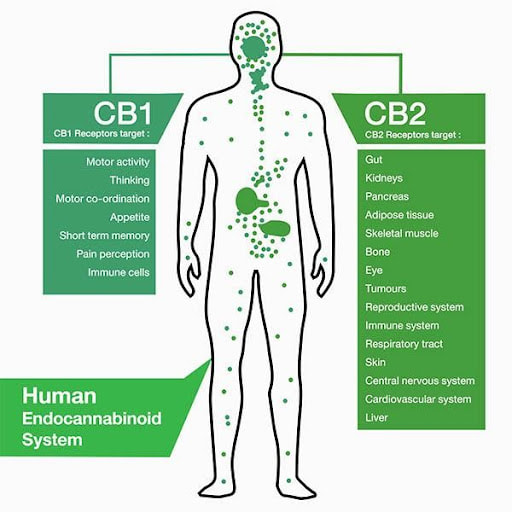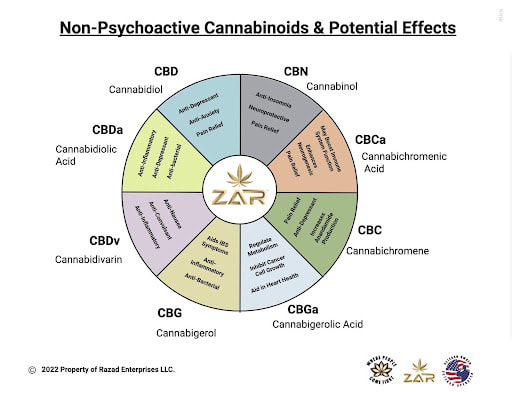|
Cannabinoids, the chemical compounds found in cannabis plants, are of different types. Each one with a different level of potency.
Knowing these levels of potencies and how they will affect you when used will help you determine which is the best one for you—and your needs. What are the different cannabinoids?
Examples of Psychoactive Cannabinoids
THC is the primary psychoactive cannabinoid in cannabis and is responsible for the plant's psychoactive effects—that is, it is the substance that causes people who use marijuana to feel high. It works by binding to cannabinoid receptors in the brain and central nervous system, leading to the release of neurotransmitters that can affect mood, memory, and other cognitive functions. THC can also affect the body's endocannabinoid system (ECS), which regulates various physiological and mental processes, including pain, appetite, and mood. The ECS is made up of two cannabinoid receptors: CB1 receptors, primarily found in the brain and central nervous system and involved in the regulation of mood, appetite, and pain perception, and CB2 receptors, primarily found in the immune system, and involved in the regulation of inflammation and immune function. Both of which get stimulated when THC is taken for users to experience the effects of cannabis.
There are several different types of THC, each with its own unique properties and potential effects. Some of the most common types include:
The effects of THC can vary depending on the individual, the kind, the method of consumption, and the dose. However, some of the general effects of THCs are altered perception, euphoria, changes in mood and behavior, dizziness, and sleepiness. It's also important to note that THC can have some negative side effects when used in high doses or prolonged use. Of course, the actual effect depends on your current tolerance to THC. So, you should start slowly and increase your dosage until you find your perfect high.
Hexahydrocannabinol, or HHC, is a cannabinoid found in tiny concentrations in hemp seeds and pollen and produced in laboratories using natural cannabinoids or cannabis extract. Hence, HHC is also often described as a semi-synthetic cannabinoid—an isomer of THC. In terms of chemical structure, THC and HHC are very similar. The only notable difference between the two is that HHC has hydrogenated carbons joined by a single bond.On the other hand, the carbon atoms of THC, share a double bond. The well-known “high” of THC stays practically the same when it becomes HHC. Although the psychotropic effects of HHC take longer to set in and last longer. Additionally, when compared to THC, HHC has slightly less effective psychoactive properties. Thus, some users may be unable to achieve a strong “high.” However, this difference is minimal, and when compared to a THC like Delta-8, HHC is more potent. HHC is available in several forms including chocolates and gummies. HHC is best used for treating anxiety and pain, as well as promoting a calming sensation.
THCv is a cannabinoid found in smaller amounts in certain strains of cannabis. It is believed to have similar effects to THC, but is generally considered less psychoactive. THCv binds to cannabinoid receptors and may produce a number of effects including appetite suppression, anxiety reduction, and the treatment of seizures.
This form of THC is found in the resin of the cannabis plant. THCp is converted to THC when the plant is heated and is believed to have similar effects to THC. It may be effective in the treatment of pain, inflammation, and anxiety and is typically consumed by smoking marijuana or through the use of THCp-based oils and tinctures.
THC-O is formed when THC is converted to THC-O by the enzyme THC-O synthase, which is found in the cannabis plant. It is found in higher concentrations in certain types of cannabis, such as Indian hemp and the resin of the cannabis plant. It has a number of potential therapeutic uses, including reducing inflammation, relieving pain, and reducing anxiety and is being studied for its potential use in the treatment of a range of medical conditions, including multiple sclerosis, epilepsy, and cancer. THC-O has a longer onset than THC or HHC because it is not active until it’s metabolized by the liver. It is available in several forms including gummies.
This form of THC is found in raw, unheated cannabis. When THCa is heated, it is also converted to THC. THCa may have potential medicinal benefits, including anti-inflammatory effects and the treatment of nausea and vomiting. Here is a table that concisely shows the benefits of some psychoactive cannabinoids:
2. Non-psychoactive cannabinoids: This group of cannabinoids, on the other hand, does not produce a psychoactive effect when consumed. Although they are mood-altering substances, they do not produce mind-altering effects or altered consciousness, such as changes in perception. Examples include, Cannabidiol (CBD), Cannabichromene (CBC), Cannabigerol (CBG), and Cannabinol (CBN). Examples of Non-Psychoactive Cannabinoids
CBD is the most well-known non-psychoactive cannabinoid found in the cannabis plant. Unlike THC, the main psychoactive compound in cannabis, CBD does not produce a "high" when consumed. It is often used to treat a variety of conditions, including anxiety, epilepsy, and pain. CBD also has various therapeutic effects, including anti-inflammatory and antipsychotic properties. Additionally, it is also thought to have neuroprotective effects, which means it may be helpful in protecting the brain from damage or degeneration. CBD is available in various forms, including oils, tinctures, and edibles. It can be taken orally, applied topically, or inhaled using a vaporizer. It is generally well-tolerated and considered safe with minimal side effects.
Cannabigerol, or CBG, is a non-psychoactive cannabinoid found in relatively small amounts in most strains of cannabis, although, some strains have been specifically bred to have higher levels of CBG. CBG is often referred to as the "mother" cannabinoid because it is the precursor to other cannabinoids, including THC and CBD. It is produced when the CBGA (cannabigerolic acid) present in the plant undergoes a chemical process where CBGA is decarboxylated—meaning the acid is heated or exposed to UV light, broken down and converted into other cannabinoids. Thus, it makes sense that it is called the parent cannabinoid or “mother” cannabinoid. It is thought to have a number of therapeutic effects, including antibacterial and anti-inflammatory properties. CBG is also believed to have neuroprotective effects and may treat conditions such as glaucoma and inflammatory bowel disease.
CBC is thought to have a number of therapeutic effects, including anti-inflammatory and analgesic (pain-relieving) properties. CBC may also have neuroprotective effects and may help treat conditions such as depression and anxiety. It is found in relatively small amounts in most strains of cannabis. However, some strains have been specifically bred to have higher levels. CBC is available in a variety of forms, including oils, tinctures, and edibles, and can be taken orally, applied topically, or inhaled using a vaporizer. More research is needed to fully understand the potential therapeutic benefits of CBC and its mechanisms of action. However, early studies have shown promising results, and CBC is being investigated as a potential treatment for various conditions. In addition to its potential therapeutic effects, CBC may also enhance the effects of other cannabinoids when combined with them.
CBN is produced when THC is exposed to oxygen and light over time, which causes it to break down and convert into CBN in a process known as oxidation. CBN can, therefore, often be found in older or improperly stored cannabis products. CBN is believed to have sedative properties and may be useful in treating insomnia. Although CBN is not psychoactive, it may still interact with the body's endocannabinoid system in a way that enhances the effects of other cannabinoids. Research on CBN is limited, and its effects are unclear. Here is a table that concisely shows the benefits of the non-psychoactive cannabinoids:
|
Categories |





